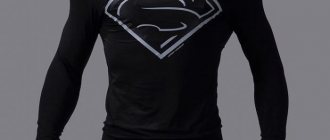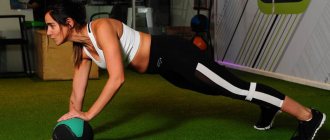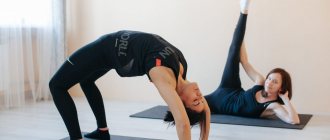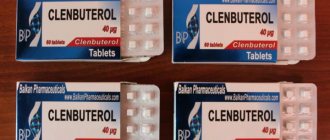What is body drying
In fitness, the concept of muscle drying means getting rid of excess fat and increasing muscle definition.
This is one of the three main training cycles, which usually completes the year's training and brings the athlete to peak form. It is customary to carry out drying in the summer, associating it with the beach season, although professional athletes are “tied” not to seasons, but to competitive performances. Drying is considered the most difficult cycle.
Unlike gaining weight and increasing strength, losing fat provides significant physical and psychological stress. Moreover, this cycle requires the most careful consideration of your diet and training regimen. The wrong approach can lead to many negative consequences, including not only loss of muscle mass, but also possible deterioration in health.
What carbohydrates are there?
During loading it is better to use:
- low-fat baked goods;
- bread;
- cereals (buckwheat, rolled oats, rice and others);
- pasta;
- marmalade;
- grape;
- carrot;
- marshmallows;
- beets;
- bananas;
- marshmallow.
Sweets, as mentioned above, should be eaten in small quantities so as not to provoke an increase in body fat. Focus on foods that you usually don’t eat when cutting or dieting (bananas, grapes, bread).
The main differences between drying and losing weight
In order for the cycle to be as short and effective as possible, you need to understand what body drying is and how it differs from regular weight loss. The term “weight loss” usually refers to a general reduction in body weight. Progress is tracked using the number on the scale. In this mode, it is physiologically impossible to achieve the loss of exclusively fat body mass. When cutting calories in the diet, the body, along with fat, will begin to burn muscle tissue for energy. This certainly leads to a decrease in physical capabilities and a decrease in muscle volume.
Drying is the targeted elimination of exclusively the fat layer while maintaining the maximum possible amount of muscle.
Main features of drying:
• Short cycles, no more than 1.5-2 months;
• Creating a controlled calorie deficit (it is necessary to determine the limit of the deficit when fat mass will decrease without affecting muscles);
• Stimulation of lipolysis and enhanced support of the body with the help of sports supplements;
• Planning of all microcycles within the drying cycle;
• Draining water when reaching peak form.
The main difference between cutting and losing weight is the preservation of muscle mass. Draining the water at the end of the course is practiced only in professional sports to prepare the athlete for a performance. For amateurs, such muscle drying will not only not bring benefits, but can also be harmful. This is due to the effects of extreme drainage of fluid from the body to maximize muscle dryness.
Who needs a download?
Let's find out who really needs a refeed and when:
- Carbohydrate loading during drying. It is recommended to do it in the middle of the cycle. Refeed helps reduce stress on the body.
- Athletes before performances. Carbohydrate loading in this case helps increase the volume of muscle tissue by approximately two centimeters.
- Athletes who require endurance during training. Carbohydrate loading before a marathon allows you to get extra energy. Sometimes marathon runners continue to refeed during the race.
- Athletes who engage in strength sports. Crossfitters and bodybuilders often practice carbohydrate loading. It helps increase strength endurance.
- Carbohydrate loading on the keto diet. This diet involves a complete abstinence from carbohydrate foods. Very often, people on this diet simply need a break. After the refeed, you can safely continue the diet without fear of losing a large amount of muscle tissue. In addition, after carbohydrate loading, a person will regain strength and the desire to continue the process of losing weight.
Refeeding before a competition or during a diet is a temporary panacea. Remember that carbohydrate loading only works if the body is depleted. The body can only respond to a stressful situation. If you have always consumed a lot of carbohydrates and decide to load, then the result of the refeed will be insignificant.
The benefits and harms of drying
Both losing weight and drying can have both negative and positive aspects. Understanding the potential disadvantages allows you to choose the most optimal option for getting rid of body fat.
Main advantages of drying:
- Improved metabolism;
- Reducing blood cholesterol levels and improving the functioning of the cardiovascular system;
- Effective prevention of fatty liver hepatosis;
- Strengthening the immune system (only after recovery from the cycle; during drying, immunity drops significantly);
- Normalization of the hormonal system;
- Drying your feet prevents varicose veins;
- Increasing natural testosterone production in men.
A number of studies show that even narrowly targeted abdominal drying can normalize and even slightly increase testosterone synthesis in men.
Disadvantages of drying:
- Harm to the body from severe dehydration: leaching of nutrients, hormonal imbalances and other consequences (relevant only for professional level athletes);
- Significant stress on the psyche (associated with a lack of calorie intake);
- Slight or moderate decrease in mental abilities;
- Increased fatigue, lethargy, drowsiness, mood changes;
- Decrease in strength indicators.
Almost all deficiencies are controllable. With the right approach they can be minimized. The only exception is drying the body for girls before performances. Extreme withdrawal of water at the final stage causes significantly more harm to the female body than to the male body. Among the main consequences: emergency weight gain (due to the accumulation of water), as well as hormonal imbalances, menstrual irregularities, and others. Therefore, without the need to prepare for competitions, athletes are categorically not recommended to use professional schemes.
In general, the main harm comes only from professional drying. For amateurs, a fat burning cycle, and even minimal abdominal drying, will have mainly advantages.
Nutrition during the drying period
Diet is the most important element of drying. In terms of the degree of impact on overall performance, the influence of diet is estimated in the range of 60-65% (the remaining 35-40% depends on training). Building a diet during the drying period is a difficult task that requires constant attention, regular calculations and planning.
Nutrition during drying comes down to control:
- Ratio of proteins, fats and carbohydrates;
- Counting calories consumed.
During the period of fat burning, the need for protein increases significantly. This is due to the need to reduce muscle catabolism (to prevent muscle breakdown). Also, protein foods are absorbed over a long period of time, reducing the feeling of hunger. Another important argument for increasing protein foods in the diet is its calorie content. Unlike carbohydrates (4 kcal per 1 gram), as well as fats (9 kcal per 1 g), the nutritional value of a gram of proteins is 3-3.5 kcal.
Body drying for men is effective with the following ratio of macronutrients:
- Proteins – 40-45%
- Carbohydrates 40-45%
- Fats – 10-15%.
For girls, the menu is formed with a slight increase in fat consumption (by 5%). The share of carbohydrates is reduced by 5%. A completely carbohydrate-free diet (ketogenic, paleo variations) is rarely used during cutting. Such a nutrition plan will greatly reduce performance and reduce the quality of training. It is optimal to control the proportion of carbohydrates at a minimum level (within the daily caloric intake). Using slow carbohydrates will saturate the body and reduce hunger without increasing insulin production.
Best sources of carbohydrates:
- Cereals (oatmeal, buckwheat, black and brown rice);
- Vegetables (especially broccoli, spinach, celery);
- Whole grain bread (no more than a few slices per day)
- Fruits with a low glycemic index.
Best sources of protein:
- Chicken breast;
- Sea fish (low-fat river fish is allowed);
- Egg whites;
- Protein supplements;
- Lean meats (turkey breast, lean beef and others);
- Low-fat dairy products.
Best sources of fat:
- Sea fish;
- Nuts;
- Avocado;
- Omega-3 supplements.
During the drying period, salt and most spices are completely eliminated. Sodium retains water in the body, and spices increase the feeling of hunger and the production of gastric juice.
During the period of fat burning, all sugar-containing, starch-containing foods, sweet drinks or juices, fast food, fried foods are excluded (only frying without oil in a non-stick pan is allowed).
One of the popular schemes is carbohydrate alternation. It involves changing the amount of carbohydrate intake by day, for example:
- Monday is a low carb day;
- Tuesday – normal carbohydrate intake;
- Wednesday – low carb day;
- Thursday – increased carbohydrate consumption in the first half of the day;
- Friday is a low carb day;
- Saturday is a low carb day;
- Sunday is a fasting day (increased consumption).
Vary the regimen by day, depending on the progression. If there are no results, it is recommended to increase the number of low-carb days by 1.
Finding the optimal amount of calories during cutting
Understanding what can be eaten dry is far from the main task. It is much more important to choose the right amount of calories. If regular weight loss allows you to reduce the calorie intake to the maximum (up to complete starvation) and lose weight due to the destruction of fat and muscle, this approach is excluded during the drying period. Taking into account different individual characteristics and metabolism, finding the optimal calorie balance can only be achieved through trial and error.
Basic algorithm for determining calorie content:
- Calculating daily calorie needs using complex calculators (be sure to use those that take into account metabolism and lifestyle, and not just body proportions);
- Reducing calories by 200-250 from normal for the first week, tracking results;
- While maintaining muscle mass and reducing body fat, calories are reduced by 50-100 per week;
- With weak or absent results, the weekly reduction increases to 150-200 kcal.
The main task is to find the deficit limit at which fat will be actively and steadily burned. Cutting calories too much is unacceptable; this will not only negatively affect muscle mass, but will also trigger “braking mechanisms” that completely stop fat burning. To track the ratio of muscle mass to fat, it is recommended to use special scales, as well as regularly take body measurements.
Gradually, the body will give off less and less fat, even as the calorie deficit increases. Cheat meals are a great way to “deceive” the body. Use fasting days, allowing you to eat any food (pizza, a piece of cake, etc., but within reason) for lunch once a week. This will not only help “shake up” your metabolism, but will also reduce psychological stress.
Training during the drying period
There are two positions regarding training. The so-called super drying, when the emphasis is on grueling training until the last days before performances (before the removal of water), as well as uniform cyclic drying (wavy). The latter is based on alternating loads in waves in each microcycle.
The main goal of training is to maintain muscle tone and volume, as well as ensure sufficient calorie expenditure for fat burning. Amateur drying of the body for girls may include minimal or no physical activity, but this option greatly worsens muscle tone and makes the appearance of the muscles unaesthetic (flabbiness and sagging of the skin in some places is also highly likely).
The number of training sessions should increase significantly. It is optimal to adhere to the standard daily schedule:
- Drying legs (multiple repetition work with 30-35% RM) + strength work on the upper body (back, shoulders, arms);
- Low-intensity cardio session – 50 minutes or more;
- Strength work on all muscles of the body + drying the abdomen (abs complex);
- Light toning lower body workout + 10-15 minutes HIIT;
- Low-intensity cardio session – 50-60 minutes;
- Strength training (full body or for lagging muscle groups) + HIIT;
- Day of active rest.
The program varies depending on your well-being, energy level and progress. For example, drying your legs during frequent running or cycling sessions can be replaced by a classic lower body workout with group work 1-2 times a week.
Strength work
It is optimal to perform 3-4 strength training sessions per week with different volumes. The use of a split system, full body or top/bottom division is individual, so athletes can choose the method that is most convenient for them. Regardless of the type of training, the bulk of the strength work should not exceed 45-50 minutes in order to reduce catabolism (70 minutes for low-intensity training with long rest periods).
It is important to avoid excessive stress on the lower body so that drying the legs does not lead to loss of muscle mass during running and other movements.
The load itself
Carbohydrate loading is carried out a week before high endurance. 3-4 days before the event, increase your carbohydrate intake to approximately 10-12 grams of carbohydrate per kilogram of body weight (70% of daily calories). Reduce high-fat foods to compensate for additional carbohydrate-rich foods. Also reduce your training. Get complete rest the day before your big event. The combination of eating more carbohydrates and tapering appears to improve glycogen storage.
How many carbohydrates you need depends on your overall calorie goal as well as your sport. For most athletes, 5-7 grams of carbohydrates per kilogram of body weight per day is a good guideline.
Cardio workout
Drying muscles is impossible without cardio. It is necessary to conduct 4-5 sessions of varying intensity per week. It is optimal to perform 3 low-intensity and 2 HIIT workouts so that the drying of your legs does not lag behind other parts of the body.
For low-intensity mode, it is recommended to change types of load using:
- Bicycle/exercise bike;
- Run;
- Orbitrek;
- Plyometric movements.
If amateur drying of the abdomen is performed, you should additionally add gymnastic movements with the active participation of the core muscles.
Your mood will change
When you eat less food, sleep poorly, do more cardio, and balance everything else in your life, your mood will not suffer. Rest assured, this is completely normal, even if you don't think so.
See also: Diet for weight loss
Advice:
Never leave home without all the food you need, rest if possible. Do as much preparation as possible when you feel energized, so that when you are exhausted, most of the work is done.










